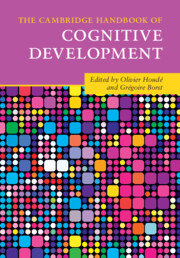Book contents
- The Cambridge Handbook of Cognitive Development
- The Cambridge Handbook of Cognitive Development
- Copyright page
- Contents
- Figures
- Tables
- Contributors
- Introduction
- Part I Neurobiological Constraints and Laws of Cognitive Development
- Part II Fundamentals of Cognitive Development from Infancy to Adolescence and Young Adulthood
- Introduction
- Subpart II.1 Infancy: The Roots of Human Thinking
- 7 Differences between Humans, Great Apes and Monkeys in Cognition, Communication, Language and Morality
- 8 Infants’ Physical Reasoning and the Cognitive Architecture that Supports It
- 9 Infant Categorization
- 10 Foundational Considerations
- 11 How Sophisticated Is Infants’ Theory of Mind?
- 12 Social Cognition and Moral Evaluation in Early Human Childhood
- 13 Scientific Thinking and Reasoning in Infants and Young Children
- 14 Computational Approaches to Cognitive Development
- Subpart II.2 Childhood and Adolescence: The Development of Human Thinking
- Part III Education and School-Learning Domains
- Index
- Plate Section (PDF Only)
- References
13 - Scientific Thinking and Reasoning in Infants and Young Children
from Subpart II.1 - Infancy: The Roots of Human Thinking
Published online by Cambridge University Press: 24 February 2022
- The Cambridge Handbook of Cognitive Development
- The Cambridge Handbook of Cognitive Development
- Copyright page
- Contents
- Figures
- Tables
- Contributors
- Introduction
- Part I Neurobiological Constraints and Laws of Cognitive Development
- Part II Fundamentals of Cognitive Development from Infancy to Adolescence and Young Adulthood
- Introduction
- Subpart II.1 Infancy: The Roots of Human Thinking
- 7 Differences between Humans, Great Apes and Monkeys in Cognition, Communication, Language and Morality
- 8 Infants’ Physical Reasoning and the Cognitive Architecture that Supports It
- 9 Infant Categorization
- 10 Foundational Considerations
- 11 How Sophisticated Is Infants’ Theory of Mind?
- 12 Social Cognition and Moral Evaluation in Early Human Childhood
- 13 Scientific Thinking and Reasoning in Infants and Young Children
- 14 Computational Approaches to Cognitive Development
- Subpart II.2 Childhood and Adolescence: The Development of Human Thinking
- Part III Education and School-Learning Domains
- Index
- Plate Section (PDF Only)
- References
Summary
For more than three decades, researchers have characterized the dramatic changes in early cognitive development and the learning mechanisms that underlie those changes by analogy to the thinking of professional scientists. This “child-as-scientist” view has emphasized the parallels between: (1) the evidence-based, theoretical nature of both children’s and scientists’ knowledge, (2) the rational process by which that knowledge is updated and revised, and (3) conceptual change, the often radical alterations to epistemic content that can result from those revisions. In this chapter, we begin by laying out the fundamentals of scientific thinking and reasoning, situating it in an “interventionist” framework of causal reasoning. Next, we review the history of the “child-as-scientist” approach in this context. Then, we outline recent work, open questions, and future directions in research on the development of scientific thinking in infancy, early childhood, and beyond.
- Type
- Chapter
- Information
- The Cambridge Handbook of Cognitive Development , pp. 299 - 317Publisher: Cambridge University PressPrint publication year: 2022
References
- 2
- Cited by



